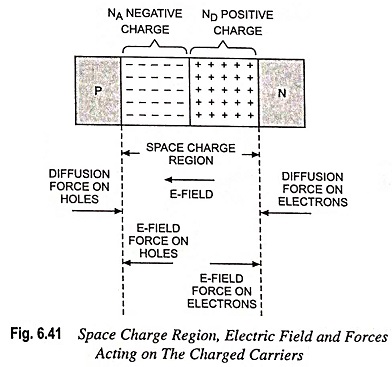Space Charge Region at a Junction:
As explained already, the interface separating the N and P-regions is called the metallurgical junction. Let us consider a step junction in which the doping concentration is uniform in each region but there is an abrupt change in doping at the junction.
Initially, at the metallurgical junction, there is a very large density gradient in both the electron and hole concentrations. Majority carrier electrons in the N-region will begin diffusing into the P-region and majority carrier holes in the P-region will begin diffusing into the N-region.
Figure 6.41 represents the net positively and negatively charged regions for a semiconductor P-N junction where there is no external connection, no applied voltage, no field etc. The net positive and negative charges in the N and P regions induce an electric field near the junction in the direction from the positive to the negative charge, or from the N-region to the P-region.
Since the electrons and holes are both pushed out of the space charge region by the electric field, the region is depleted of any mobile charge and is called the depletion region. Density gradients still exist in the majority carrier concentrations at each edge of the space charge region.
A density gradient may be considered as producing a “diffusion force” acting on the majority carriers. These diffusion forces, acting on the electrons and holes at the edges of the space charge region, are indicated in the figure. The electric field in the space charge region develops another force on the electrons and holes which is in the opposite direction to the diffusion force for each type of particle. In thermal equilibrium, the diffusion force and the E-field force exactly balance each other.
